PAGE 35 – MARCH 2005
SMALL LAYOUT VARIETY PACK
Small layouts come in many shapes, scales, and even sizes. Here’s
a “Variety Pack” of interesting small layouts that have reached our
desk over the past few months. Enjoy!
MAKING AN A’PIER’ANCE!
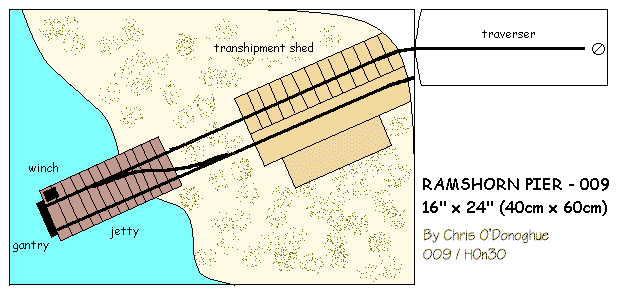 Photo adapted from The Railways of Purbeck (Oakwood Press)
Photo adapted from The Railways of Purbeck (Oakwood Press)
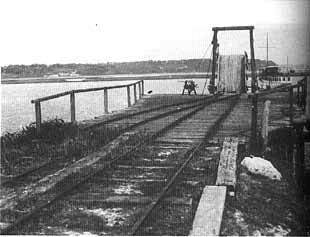 Frequent contributor Chris O’Donoghue, of Greenwich & District Narrow Gauge Railway Society in England, acknowledges several inspirations for his design of Ramshorn Pier — an elegant little layout for 16×24 in.
Frequent contributor Chris O’Donoghue, of Greenwich & District Narrow Gauge Railway Society in England, acknowledges several inspirations for his design of Ramshorn Pier — an elegant little layout for 16×24 in.
“The inspiration for Ramshorn Pier came from two sources,” says Chris. “One is a wonderfully evocative picture of the loading ramp on Goathorn Pier (at right) which reminds me of my youthful days sailing in the harbour at Poole in Dorset. Then, in the August 2003 copy of Railway Modeller magazine, a layout by Neil Rusby called Shell Island, sparked my imagination.
“The modelling is so restrained and subtle that he has really caught the splendid isolation of the remote setting. As a result, Ramshorn Pier was conceived. I’ve borrowed Neil’s track plan as it easily serves the purpose I have in mind. Just two lengths of track connected by a pair of facing turnouts and a simple traverser.
“A small IC loco pulling a short train of, say three or four, end-tipping skips leaves the traverser and enters the layout through the back of a tumbledown transhipment shed. It then proceeds on to the jetty where the loco uncouples, and runs back through the shed to the traverser and returns so it can propel the wagons on to the short siding.
“It then picks them up, one at a time, so they can discharge their loads of ball clay into a waiting barge via the loading chute. (It should be fairly easy to motorise the winch so the chute can be raised and lowered). A certain amount of juggling will be required to access each of the skips which should provide some puzzlement and entertainment. In addition, a van or open wagon could be left on the siding, causing a little more head-scratching.
“I’ve purposely slewed the track diagonally across the board in order to leave open space to enhance the impression of isolation. Lots of sand, rough grass and scrubby bushes should be all that’s needed in the way of scenics. The tide could be modelled out, leaving lots of lovely slimy mud although I rather like Neil’s turquoise sea.
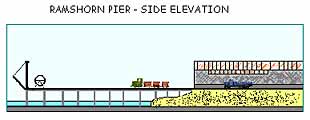 “Again I’ve borrowed from Neil’s layout, this time the curved backscene, which would just need a coat of sky blue paint to enhance the openness. With a staged presentation: proscenium arch, wings and nice bright lighting it would look good on display even when not being operated.”
“Again I’ve borrowed from Neil’s layout, this time the curved backscene, which would just need a coat of sky blue paint to enhance the openness. With a staged presentation: proscenium arch, wings and nice bright lighting it would look good on display even when not being operated.”
ROUND AND ROUND 1: ROSIE CIDER FARM
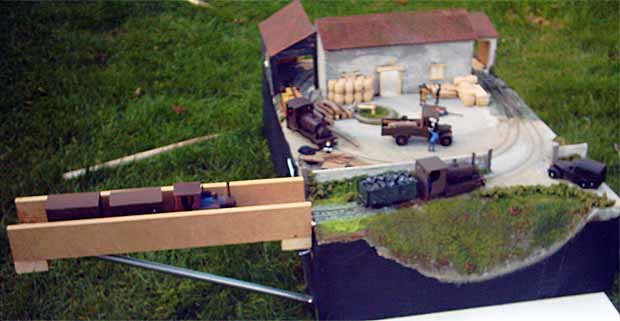 Andrew L. Smith, from Chelmsford, Essex in England, built this little 30×20 inch layout for the annual “Narrow Minded” competition of the Chelmsford & District MRC. Inspired by a leaflet from the Musée du Cidre from Vannes (Brittany), the layout is built to O scale (roughly 7mm to the foot) and uses 16.5mm gauge. It’s based on a cider farm.
Andrew L. Smith, from Chelmsford, Essex in England, built this little 30×20 inch layout for the annual “Narrow Minded” competition of the Chelmsford & District MRC. Inspired by a leaflet from the Musée du Cidre from Vannes (Brittany), the layout is built to O scale (roughly 7mm to the foot) and uses 16.5mm gauge. It’s based on a cider farm.
As cider-making is a rural pastime, comments Andrew, “I hope it looks like it is set in the country. As you can see the buildings are sound but are in need of a lick of paint. All the orchards are ‘Off Stage’ and as may have been noticed this cider farm uses trains!
“I had to get the trains to go round and round as I always do for these competitions, because I tend to leave Matthew in charge and … well it is a long day for him, and I suppose you cannot blame him for getting bored. I have fitted a form of [removable] fiddle yard on the side to make it look as if the trains leave the yard for the orchards and ‘The rest of the World’.”
(Lower left photo by Emrys Hopkins, Official Photographer for this site.)
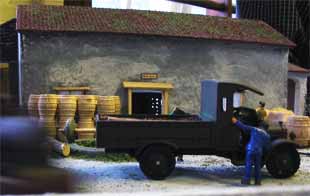
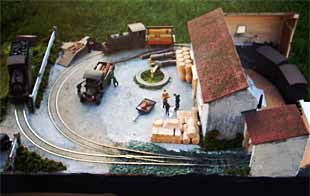
ROUND AND ROUND 2: A SWEDISH TREAT
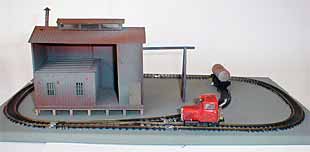 Roger Jansson, from Frövi, Sweden, is building this 48.5×29 cm (19×11 in) micro layout in the unusual gauge of 12mm, using Tillig HOm track materials. Although the layout is in O scale (1:45) — the loco shown is kitbashed from 1:43 lorry (truck) using a German BEMO 9mm motor chassis with the wheels spaced wider! We’ll look forward to seeing some photos of the finished layout. Meantime you can check out Roger’s work at his website.
Roger Jansson, from Frövi, Sweden, is building this 48.5×29 cm (19×11 in) micro layout in the unusual gauge of 12mm, using Tillig HOm track materials. Although the layout is in O scale (1:45) — the loco shown is kitbashed from 1:43 lorry (truck) using a German BEMO 9mm motor chassis with the wheels spaced wider! We’ll look forward to seeing some photos of the finished layout. Meantime you can check out Roger’s work at his website.
SHELVES 1: GNOTTER YARD
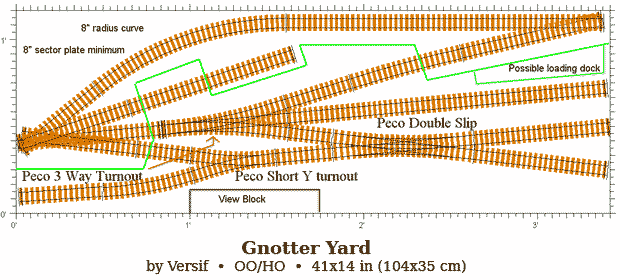
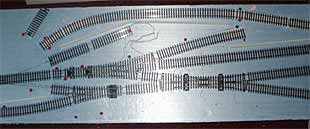 Versif, a pseudonymous contributor from Kirkby in Ashfield, Nottinghamshire in England, has by his own admission “gone overboard on track” in designing Gnotter Yard, a 16.5mm gauge switching nightmare.
Versif, a pseudonymous contributor from Kirkby in Ashfield, Nottinghamshire in England, has by his own admission “gone overboard on track” in designing Gnotter Yard, a 16.5mm gauge switching nightmare.
To give him credit, however, he’s actually building the beast (see construction photo at left) and will operate it in Gn15 no less! He’s adapted Emrys Hopkins’ design for Knotter Yard, which I have adapted to Gn15.
Notice that Versif has added two sector tables to the design — a 10-inch table on the left to hold a loco and three Gn15 wagons (cars), and an 8-inch table on the right that holds a loco and two wagons. This asymmetrical arrangement will further add to the switching crew’s headaches, already hopelessly confused by the puzzle switches!
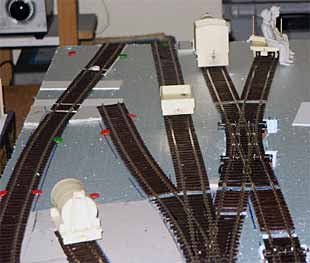 “I imagine the scene as a small works,” says Versif, “akin to those I saw when I lived in Sheffield… The building, outlined in green, projects beyond each sector table to help hide their existence, and I’ve shown one view block intended to assist minimising views into the actual works… Surface of the yard should probably be cobbles, but concrete can also be used, especially if cobbles show through in some areas.”
“I imagine the scene as a small works,” says Versif, “akin to those I saw when I lived in Sheffield… The building, outlined in green, projects beyond each sector table to help hide their existence, and I’ve shown one view block intended to assist minimising views into the actual works… Surface of the yard should probably be cobbles, but concrete can also be used, especially if cobbles show through in some areas.”
The posed photo at the right shows rolling stock in an early stage of construction, artfully scattered on the layout to illustrate size and siding capacities.
UPDATE 1: A SHOEBOX IN TT GAUGE
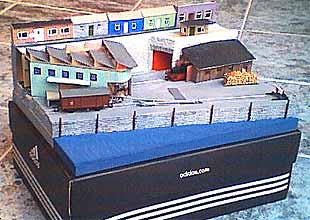
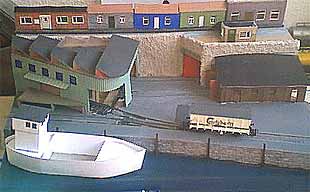
Alexander Lehmann, from Mannheim, Germany, is a fast worker. Here is an update on recent developments at his TT scale shoebox layout, first described in the January 2005 Scrapbook. Alex has added some delightful harbor scenery to the “bare bones” layout we saw two months ago … and most recently (at right) he’s begun building a ship for the harbor, dramatically improving the waterfront atmosphere and “feel” of the railway. Isn’t it amazing how much TT railroading you can cram into the space of a shoebox?
UPDATE 2: ON THE SWISS-U.S. NARROW GAUGE
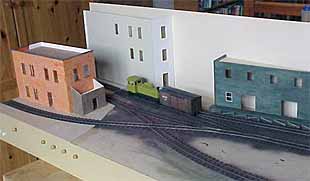 We’ve previously featured the work of Daniel Schläfli, from Switzerland, who’s building a U.S. style On30 pike called 47th Street Yard measuring 48 x 20 inches (120×50 cm). Daniel has begun to add scenery, blocking in the tall buildings that are so characteristic of urban switching areas. This photo shows his progress. We’ll show more as things develop.
We’ve previously featured the work of Daniel Schläfli, from Switzerland, who’s building a U.S. style On30 pike called 47th Street Yard measuring 48 x 20 inches (120×50 cm). Daniel has begun to add scenery, blocking in the tall buildings that are so characteristic of urban switching areas. This photo shows his progress. We’ll show more as things develop.
MORE SHELVES: LANSDOWNE SIDINGS IN N
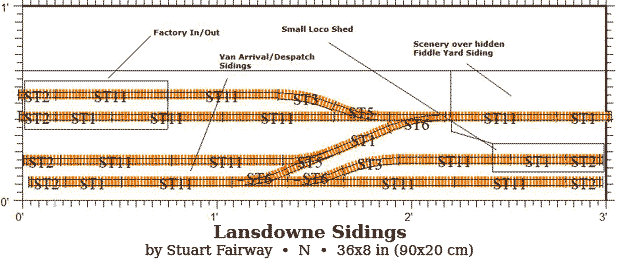
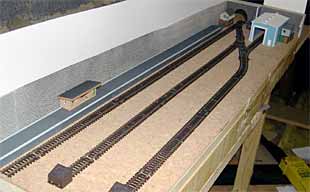 Stuart Fairway is building Lansdowne Sidings, a British Railway mainline layout depicting an industrial sidings sometime in the 1980’s or early 1990’s. It’s N scale and was started in August 2004. At right is the most recent construction photo provided by Stu, which shows the usual changes that occur between design and construction. You can follow Stu’s further progress on his blog.
Stuart Fairway is building Lansdowne Sidings, a British Railway mainline layout depicting an industrial sidings sometime in the 1980’s or early 1990’s. It’s N scale and was started in August 2004. At right is the most recent construction photo provided by Stu, which shows the usual changes that occur between design and construction. You can follow Stu’s further progress on his blog.
EVEN MORE SHELVES: O SCALE IN 5 FEET OF LENGTH!
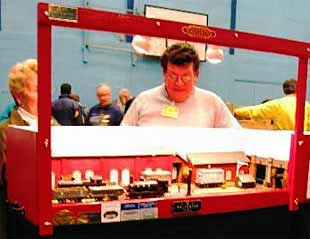
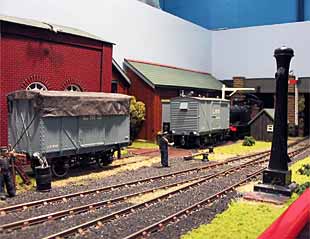 Colin French, who is an inveterate O scaler, once declared, “No O scale layout should be longer than five feet!” This is a sentiment I can completely endorse, and Colin’s Wolverton Works layout is a wonderful example. It’s been on the exhibition circuit for several years now, but still looks and runs great. Here’s the builder’s description:
Colin French, who is an inveterate O scaler, once declared, “No O scale layout should be longer than five feet!” This is a sentiment I can completely endorse, and Colin’s Wolverton Works layout is a wonderful example. It’s been on the exhibition circuit for several years now, but still looks and runs great. Here’s the builder’s description:
“This layout is not a scale model of any particular part of Wolverton Works but a cameo of various parts the builder remembers of the Works having been born and bred in the town. The layout is a minimum space shunting layout with the wagon repair shops to the left and the Stratford Road over bridge making the scenic break at the right hand end. The backscene represents further workshops and the stores, which are served by a working wagon turntable and shunted by rope or chain and capstan to create a bit more interest.
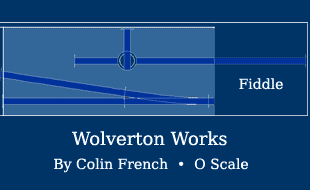
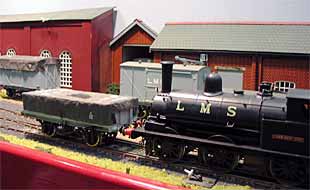
“The shunting is carried out by putting wagon labels on a board at the back of the layout and shunting the wagons in the same positions as the labels, which have been randomly picked out. Locomotives in use include one of the Wolverton Works LNWR Special Tanks and various other tank engines associated with the Works over the years.
“The period depicted is the LMS in 1935.” (Photos by Emrys Hopkins, Official Photographer of this site.)
YET ANOTHER SHELF: WHAT’S ON YOUR COMPUTER TABLE?
 Martin Hogg, from Mansfield, England, tried out some new ideas to produce this tiny shelf layout, Middle Street, that fits on his computer desk. Reports Martin: “I tried out a few new (for me) techniques … foamcore and balsa construction, a sector plate (works at about 70% success rate I reckon), and battery control.
Martin Hogg, from Mansfield, England, tried out some new ideas to produce this tiny shelf layout, Middle Street, that fits on his computer desk. Reports Martin: “I tried out a few new (for me) techniques … foamcore and balsa construction, a sector plate (works at about 70% success rate I reckon), and battery control.
“The size of the new layout is 14 x 76 cm. (5.5 x 30 in). The plan is a mini-Inglenook, using five wagons on three sidings, holding 2,3 and 2 wagons and a sector plate which holds the shunter and two (small 4 wheel) wagons. Operation consists of shuffling cards representing each wagon and shunting to place them all in the determined spots.
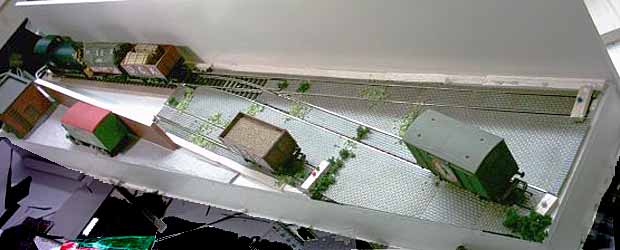 “Construction is very light and cheap, using mostly foamcard and balsa. I’ve continued in the thrifty vein by using existing spare bits of 00 track and one PECO electrofrog point to build a simple little yard. I’ve also had a first attempt at building a sector plate and this seems to work quite well. I used some 6mm MDF for this as I felt it needed the rigidity and I didn’t know whether balsa or foamcard would stand up to regular movement in the same way. It pivots on a simple bolt on a sheet of plastic card to aid smooth movement.
“Construction is very light and cheap, using mostly foamcard and balsa. I’ve continued in the thrifty vein by using existing spare bits of 00 track and one PECO electrofrog point to build a simple little yard. I’ve also had a first attempt at building a sector plate and this seems to work quite well. I used some 6mm MDF for this as I felt it needed the rigidity and I didn’t know whether balsa or foamcard would stand up to regular movement in the same way. It pivots on a simple bolt on a sheet of plastic card to aid smooth movement.
“The sector plate and one point are controlled by rods of stiff wire and the power provided by a battery pack with four AA batteries wired up to a DPDT switch for directional control. (Another first for me).”
Notice the coincidental similarity between Martin’s plan and the Wolverton Works plan above — this is a excellent track design for an operating minimum space layout. For more information about Middle Street, see Martin’s web site.
A FINAL SHELF: A FRENCH BRANCH TERMINUS
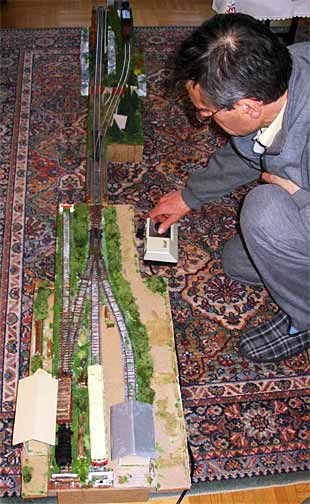
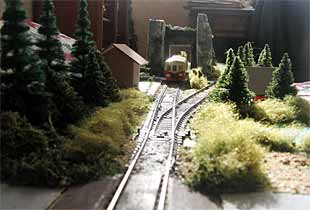 Stephane Truc, from Lyon, France, is building this tiny shelf layout in HO. It represents the terminus of an imaginary branch line in the Jura mountains (near the Swiss border), an area Stephane likes to visit. The terminus measures 85×25 cm (33×10 in). At home, Stephane attaches a small three-track traverser at the right end to act as a fiddle yard and to represent the “rest of the world”.
Stephane Truc, from Lyon, France, is building this tiny shelf layout in HO. It represents the terminus of an imaginary branch line in the Jura mountains (near the Swiss border), an area Stephane likes to visit. The terminus measures 85×25 cm (33×10 in). At home, Stephane attaches a small three-track traverser at the right end to act as a fiddle yard and to represent the “rest of the world”.
When he has more room to set up the layout, a 150 cm (59 in) extension (shown at right, above) is connected by a bridge to the layout. The extension represents one of the Jura mountains, which conceals a fiddle track (feeder yard) behind it. You can just see the start of the mountain cliff at the right of the extension photo.
Much of the rolling stock is German and also frequently runs in France. Stephane recently had the opportunity to ride a DMU or railcar (visible in model form at the rear of the right-hand photo) between Morez and Champagnole in this same area — a very nice ride! Note that because of the three-way lap switch, the terminus trackage can be used as an Inglenook switching game if desired. Good use of a very small space!
Leave a Reply